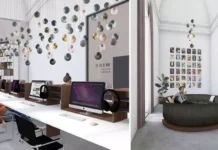
Students spend most of their day in class. The learning experience and effectiveness of the process depend on the perception students build about the class. The design of the class will make learning appealing and memorable.
A good design makes the students feel welcome into the class and are receptive to learning. The traditional learning environment was centered around the teacher. However, a new philosophy favors an engaging and collaborative environment. Further, the inclusion of other learning resources like technology and molds demands a reorganization of the space. Here are classroom designs ideas that create a smart learning space.
Create segments
The timetable is a perfect guide on how your classroom should appear. Provide room for all the subjects that are indicated on the timetable. A space for biology, language, creative work, and emerging topics will help the student to experience the difference. A technology corner, for example, will come with computers that allow internet access. They can access homework help websites at https://domyhomework123.com/ and other online learning resources that make the class more engaging.
Change in sitting arrangement or facing a particular part of the wall helps the students to switch their mentality with each topic. The segments may also be identified using different colors, patterns, or learning resources. It makes learning more engaging by eliminating the boredom of facing the same direction.
Prepare engaging desks and tables
The furniture you use in class will define the learning experience. Traditional designs focused on providing writing space while the student faced the board. The modern class and learning philosophy is collaboration. The teacher is not pinned at the front of the class. Students have more room to discuss ideas with peers during the lesson. The furniture you provide should create room for interaction.
The tables should be easy to use in creating tables of different shapes. At the same time, they must facilitate the teacher’s movement during the lesson. Students should easily gather and follow the class using one gadget or while observing the same specimen. It makes the class easier to organize based on expected activities for the lesson.
Use movable furniture
Furniture used should not have roots. The design of the class will change from time to time. Students may face a different wall or direction when using resources placed at a particular corner. If the desks and tables are difficult to move, it will be a challenge to reorganize your classroom.
Beyond movement, the furniture should allow students to conveniently sit in different positions. For instance, the students can turn to watch a screen on the side without spending five minutes to reorganize the class. If you wish to change the design of the class, it should be easy and seamless to give your lesson a different feel.
Avoid block designs
The block design is outdated. The teacher and the board at the front were the center of attraction. The new design places the student at the center. It also makes the class more engaging. It must make it easy for students to shift attention to different parts of the class.
The block design disadvantages some of the students. They sit too far from the board or screen in all lessons. Dynamic class setting and design allow students to exchange privileges, avoiding the isolation of some of the students.
Choose the right furniture
Students spend the entire day sitting on the chairs and writing on tables. The furniture must, therefore, guarantee comfort. They should come at the right height. Provide ample space on the desk for all the activities you wish to undertake. The right furniture also allows you to change the appearance of the class within minutes. Pick appropriate color and design for each grade. A comfortable study space will enhance the learning experience.
Use the walls and ceilings
Walls and ceilings occupy a large space that can define the learning experience. They are resources that can be used for presentations, hanging charts, and changing the texture of the class. Allow students to use walls for different demonstrations. Tell stories using the walls. Such dynamic uses on the walls make it interesting for your academic work.
As students change attention from the main board to another wall, they have a different experience. It is also one of the ways to avoid isolation since students nearer to the wall will now be at the front. The ceiling can also be used to provide a different dimension when teaching.
Integrate technology
Integrate technology in your class and provide room for the technology in your classroom design. Consider the most comfortable position for a screen. If you have a lab section in the class, it should be easy to access in the middle of a lesson.
Presentations and live streaming are also becoming an ordinary and crucial part of every lesson. Position the screen in a way that accommodates each student. Projectors can also be used to avoid the limitation of students facing one direction. By integrating technology, learning becomes engaging and enjoyable.
Maintain general class rules
Smart design does not erase the standard requirements of a classroom. The teacher remains the facilitator. It should be easy to access all corners and guarantee the safety of students. Each student must feel accommodated in whichever design you adopt. The teacher should also maintain control over the class.
Avoid isolated corners
Isolating students may affect their self-esteem. The student may also unintentionally lag behind. Organize the class in such a way that there are no isolated corners. Use the corners for resources like gardens or labs. It will prevent some of the students from feeling too distant from the teacher.
Involve the kids
Engage the students in designing the class. They have ideas that could enrich your own. It is also one of the ways to make them comfortable with whichever idea you settle for. Guide them in developing an accommodative design that fits within the required tenets.
A smart class accommodates the learning styles of different students. It is imaginative and will help students to enjoy the learning experience. While you pick innovative designs, they must maintain the standard requirements of a classroom to facilitate smooth learning.
Read Also: Beyond the Classroom: Embracing Experiential Learning for Enhanced Education


































































